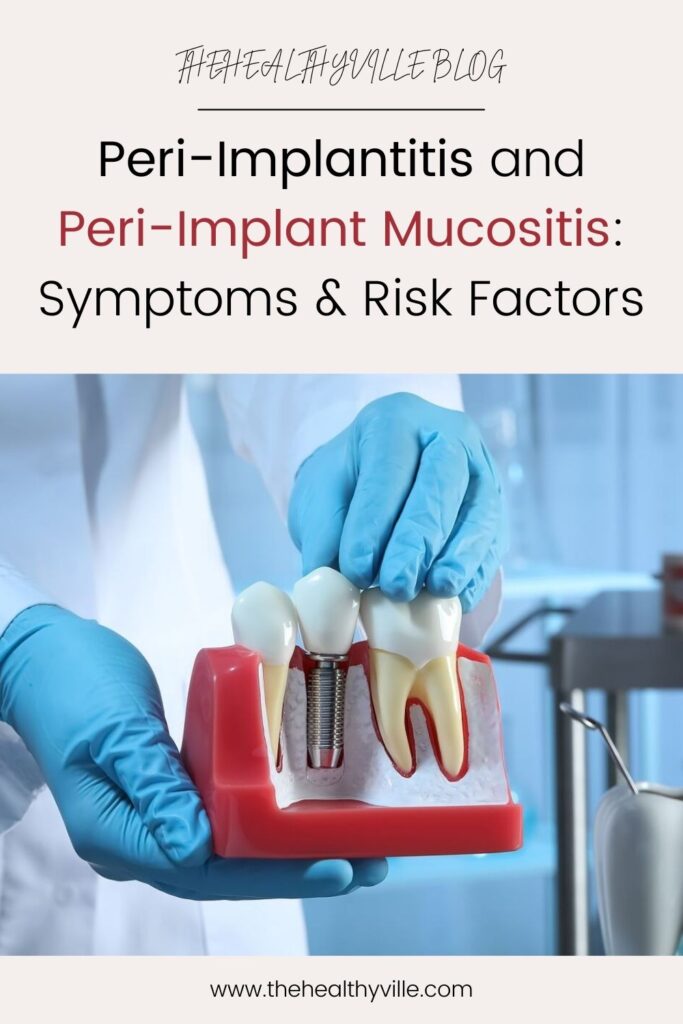Peri-implantitis and peri-implant mucositis are two complications that can appear when you get an implant. Know everything about them!
After placing a dental implant some complications may appear. We tell you more about peri-implant mucositis and peri-implantitis.
Placing an implant in the mouth is one of the most stable and aesthetic solutions to recover a lost tooth. However, it is not without its risks. Peri-implant mucositis and peri-implantitis are possible complications.
Both inflammatory conditions can occur when care after surgery is not adequate. In turn, there are other factors that also favor its development. Some of its clinical manifestations include redness, pain, bleeding, and even bone loss around the implant. How is it intervened?
What are peri-implant mucositis and peri-implantitis?
Peri-implant mucositis and peri-implantitis have dental implants as a common denominator. Both pictures are characterized by the development of an inflammatory process that requires immediate treatment.
Peri-implant mucositis is the inflammation that develops on the mucosa surrounding the implant. Its appearance is similar to that of gingivitis, since it is the gingival tissue that swells, turns a deep red color, bothers and bleeds.
The presence and accumulation of bacterial plaque on the implant surface is what causes the inflammatory reaction in most cases. Still, there are other factors that favor its development.
When there is no timely and adequate treatment, the process progresses and leads to peri-implantitis. In this case, not only the soft tissues are affected, but also the hard tissues surrounding the implant. There is even loss of the bone that supports the implant. Thus, the screw loosens and reduces the stability of the prosthetic treatment.
In very advanced cases, loss of the attachment is a possibility. This is what is called “peri-implant failure”.
Regarding the prevalence of these complications, the current data lack uniformity or only reach results from small samples. A study evaluating patients rehabilitated with implants between 2008 and 2015 in a university clinic in Peru found a prevalence of 49.8% of peri-implant mucositis and 17.5% of peri-implantitis.
According to data collected by the 2008 Consensus Report of the Sixth European Workshop on Periodontology, 80% of patients had mucositis and 28% peri-implantitis. Therefore, it follows that these conditions are a fairly common possibility after having an implant placed.
Symptoms
These inflammatory processes cause a series of clinical manifestations on the affected tissues. The most common are the following:
- Swelling and swelling of the gingival tissue in the area of the implant.
- Redness of the gum.
- Increased probing depth (measurement of the distance from the gingival margin to the base of the periodontal pocket or the attachment of the gingiva to the edge of the implant).
- Bleeding during brushing or probing.
- In the case of peri-implantitis, there are also the following symptoms:
- Mobility or loosening of the implant.
- Suppuration.
- Pain.
Risk factors
The main cause for the development of peri-implant mucositis and peri-implantitis is the proliferation of bacteria in the implant area. In any case, there are other less common factors that can also favor its development. Let’s see in detail.
Infectious aetiology is the most common cause of peri-implant mucositis and peri-implantitis. Poor dental hygiene and the consequent accumulation of bacterial plaque on the implant area is usually the origin of these problems.
Infrequent tooth brushing or with an incorrect technique tends to cause the deposit of bacteria and food debris around the implants. Bacterial plaque can also accumulate due to the placement of poorly designed prostheses that make oral hygiene difficult.
The accumulation of tartar on the implant is similar to that which occurs on natural teeth. Therefore, if not removed with proper dental hygiene, it causes inflammation of the surrounding tissues.
If there is no timely treatment, loss of the mucosal seal around the implant occurs. Pathogenic bacteria proliferate in depth and cause the bone loss that characterizes peri-implantitis.
Smoking
Smoking has negative effects on periodontal tissue. Nicotine is the main responsible for these consequences, since it causes vasoconstriction of the blood microcirculation, alters the functions of the immune system and increases platelet aggregation.
In addition, carbon monoxide decreases tissue oxygenation. Cytotoxicity affects fibroblasts and cells of the defense system. In fact, when placing an implant, the effects of cigarettes translate into less bleeding and worse healing.
It also produces a greater loss of alveolar bone. Therefore, there is sufficient evidence to conclude that smoking increases the risk of complications after implant placement.
History of previous periodontitis
Having had periodontitis before placing an implant predisposes to complications such as peri-implant mucositis and peri-implantitis. Patients with this history also often have genetic, immune, and microbiologic susceptibility that raises the odds of having these types of issues.
However, it is the maintenance of gingival health after the placement of the abutments that determines the success of the treatment. With the appropriate practices and therapies, this history of the disease does not have to be the cause of a new lesion.
Thus, if there is active periodontal disease, it is necessary to treat it before placing the implants in the mouth. Otherwise, the risk of peri-implantitis is great.
Systemic diseases
The presence of certain systemic conditions influences the status of the periodontal and peri-implant tissues of patients. Thus, suffering from some disorders can affect the permanence of the implants in the mouth.
Diabetes
Diabetes is the disease that most influences the tissues that support the teeth or implants. Without adequate control, the ability to heal and the immune response are compromised. For this reason, any surgical intervention —even the placement of an implant in the mouth— is risky.
In any case, having diabetes is not an impediment to having implants. With proper controls and strict maintenance, this type of oral rehabilitation is possible.
Hypothyroidism
Hypothyroidism is another disease that can predispose to these inflammatory processes. Thyroid hormone participates in the regulation of numerous physiological processes, such as hemostasis and wound healing.
Because of this, patients with this condition may experience complications when having an implant. Low levels of thyroid hormone can lead to destruction of peri-implant tissues.
Osteoporosis
Osteoporosis is a metabolic disease that alters the mass and density of bone, especially cancellous bone. And although this disease is often associated with the failure of the implants, the truth is that there are no convincing studies that prove it.
Despite this, there appears to be a relationship between patients suffering from osteoporosis. For this reason, long-term maintenance and post-surgical controls are essential.
Implant Placement
The success of the treatment also depends on the material of the implant, the way it is placed or the health of the surrounding tissues. Less frequently, the development of peri-implant mucositis or peri-implantitis can occur due to any of the following situations:
Retrograde peri-implantitis: the presence of periapical processes of underlying teeth or cysts of radicular remnants can give rise to lesions in the apical portion of the implant, with the healthy coronary area.
Rough surface: many times the implants are treated and covered with special materials that try to increase the speed of the implant-bone union. This greater roughness generates an accumulation of bacteria and favors the development of peri-implant mucositis and peri-implantitis.
- Occlusal overload: once the doctor places the prosthesis is on the implant, it receives the occlusal forces of chewing. But in the event that there is an overload, the supported forces are excessive or poorly distributed, the risk of developing peri-implantitis increases.
- Excess of cement: the excessive use of dental cements to fix the prosthesis to the implant favors the retention of bacterial plaque and the inflammation of the tissues.
- Allergy to titanium: it is something uncommon, but there may be cases of patients with hypersensitivity to the titanium.
Treatment
After undergoing dental implant surgery, periodic check-ups are necessary to avoid the setbacks that we are discussing here. During visits to the dentist, the professional will be able to evaluate the evolution of the treatment, the integration of the material to the bone and the state of the tissues surrounding the prosthesis.
If after the review you notice any inconvenience, you can apply the appropriate treatment immediately to prevent its evolution to more serious conditions. The most used therapeutic options to resolve peri-implant mucositis and peri-implantitis are those mentioned below.
Don’t forget to SHARE everything you now know about peri-implantitis and peri-implant mucositis with your friends and family on your social networks!

